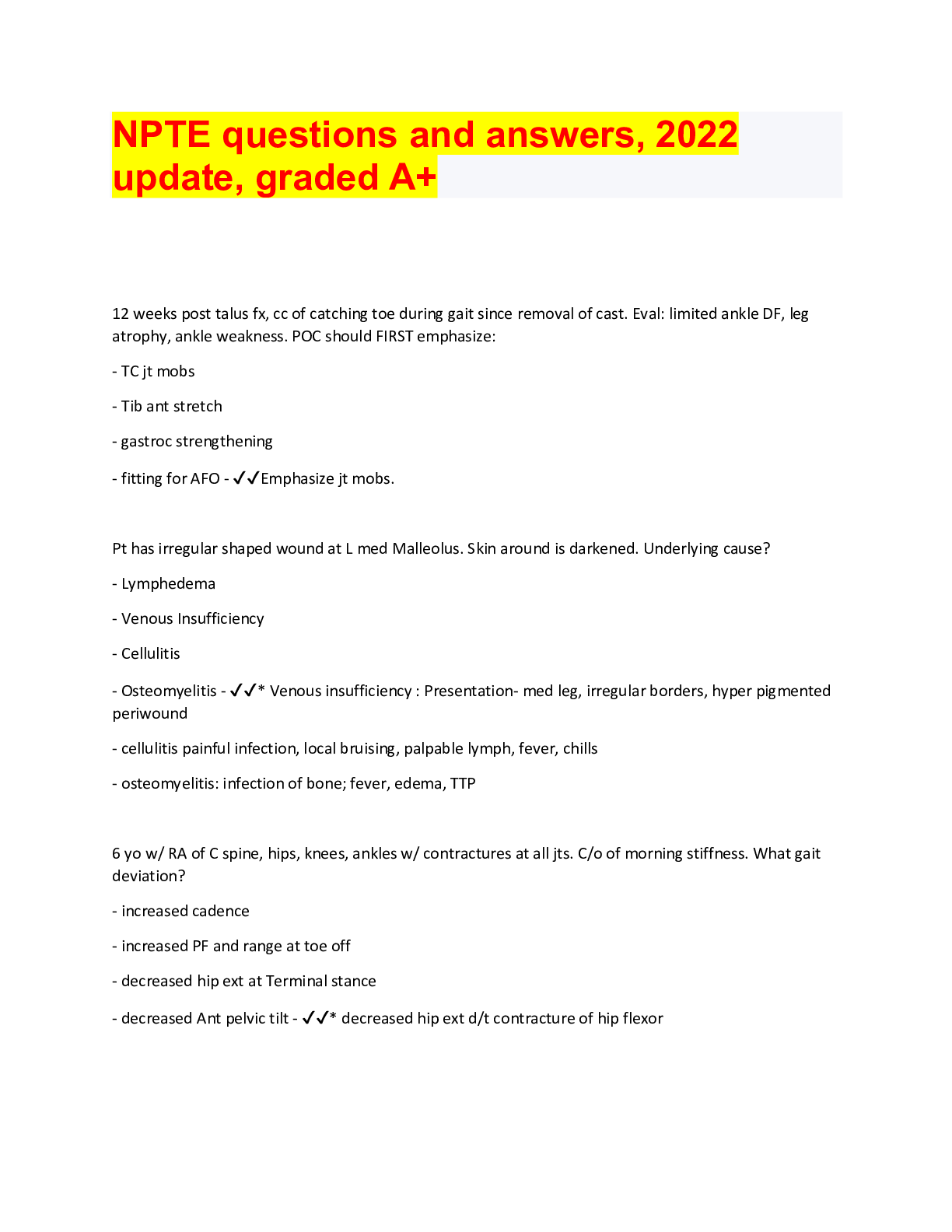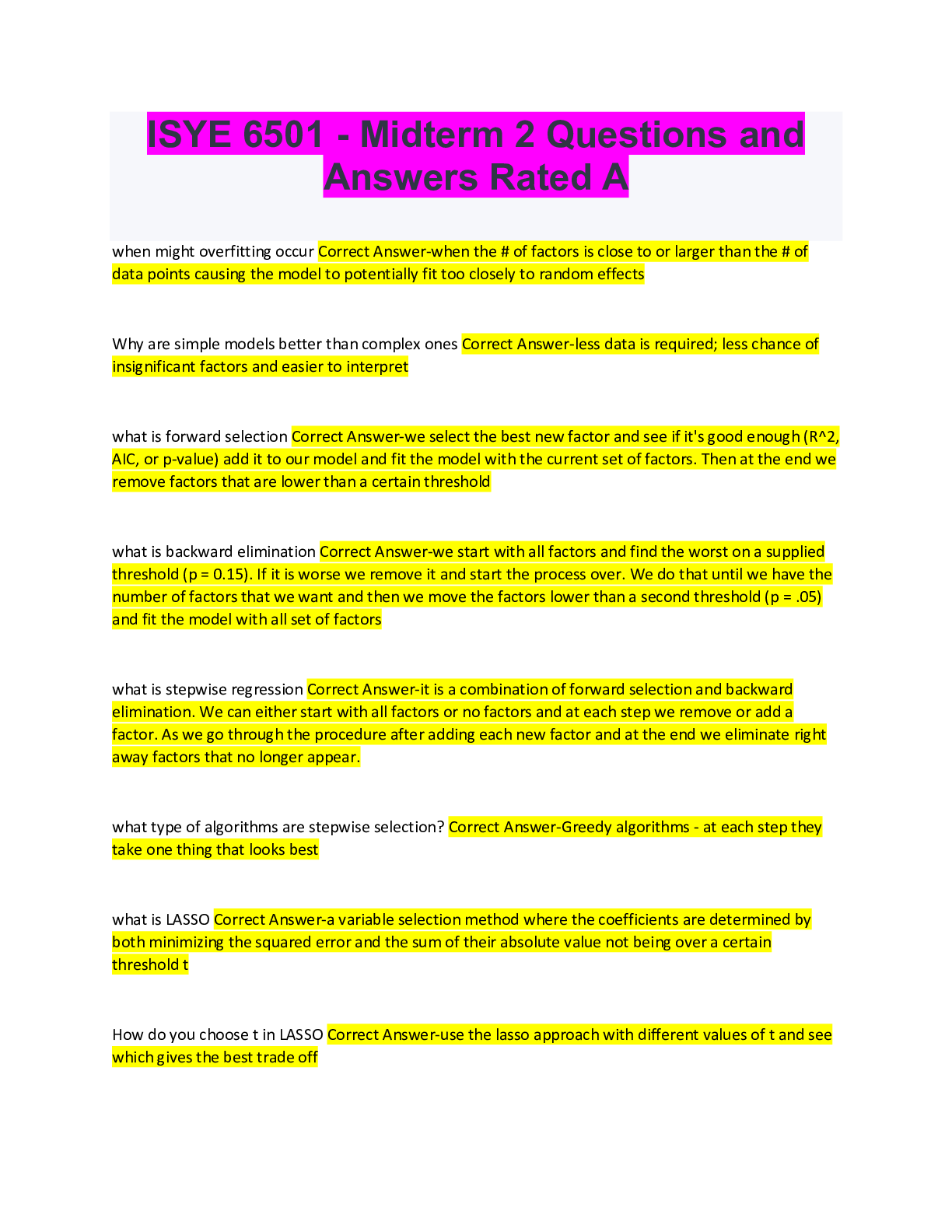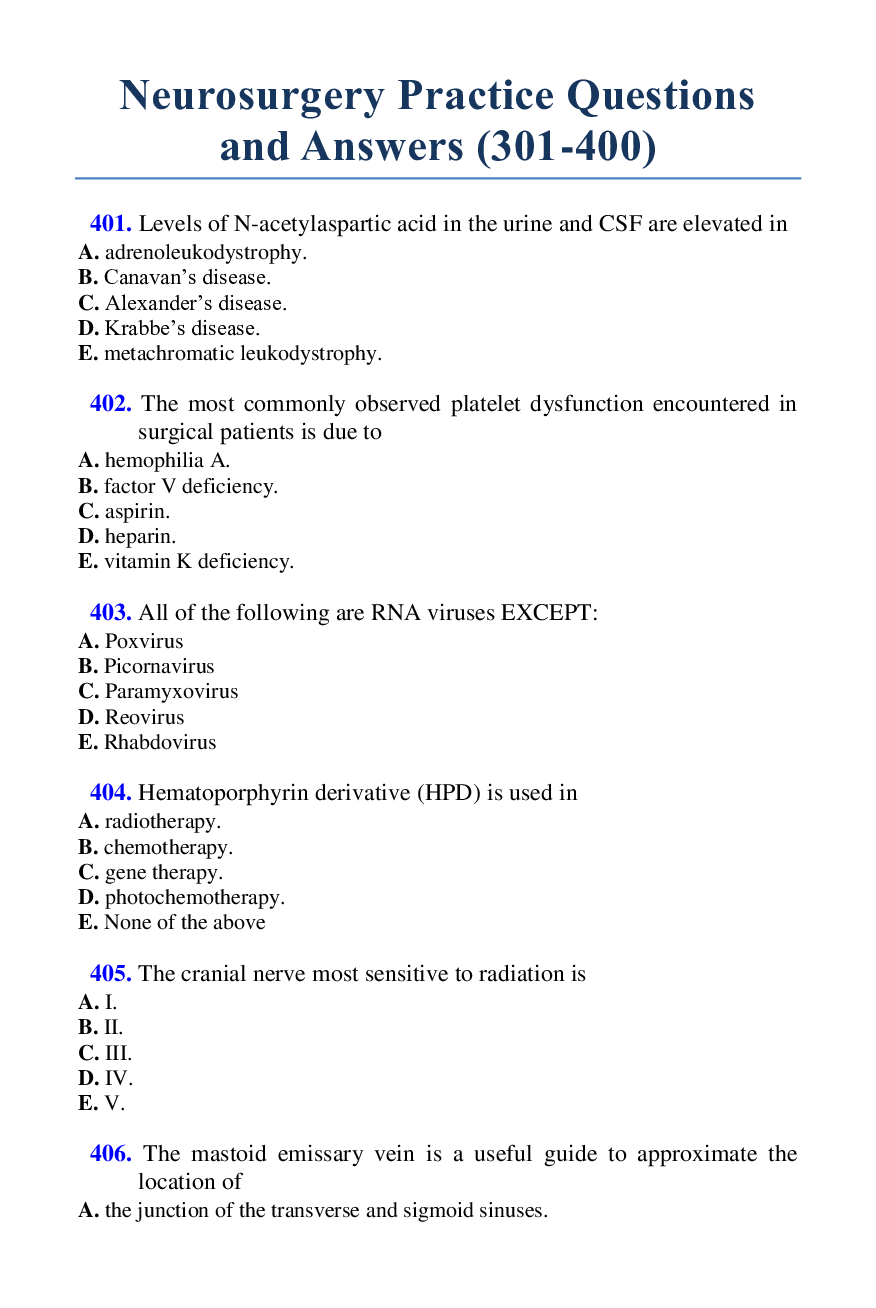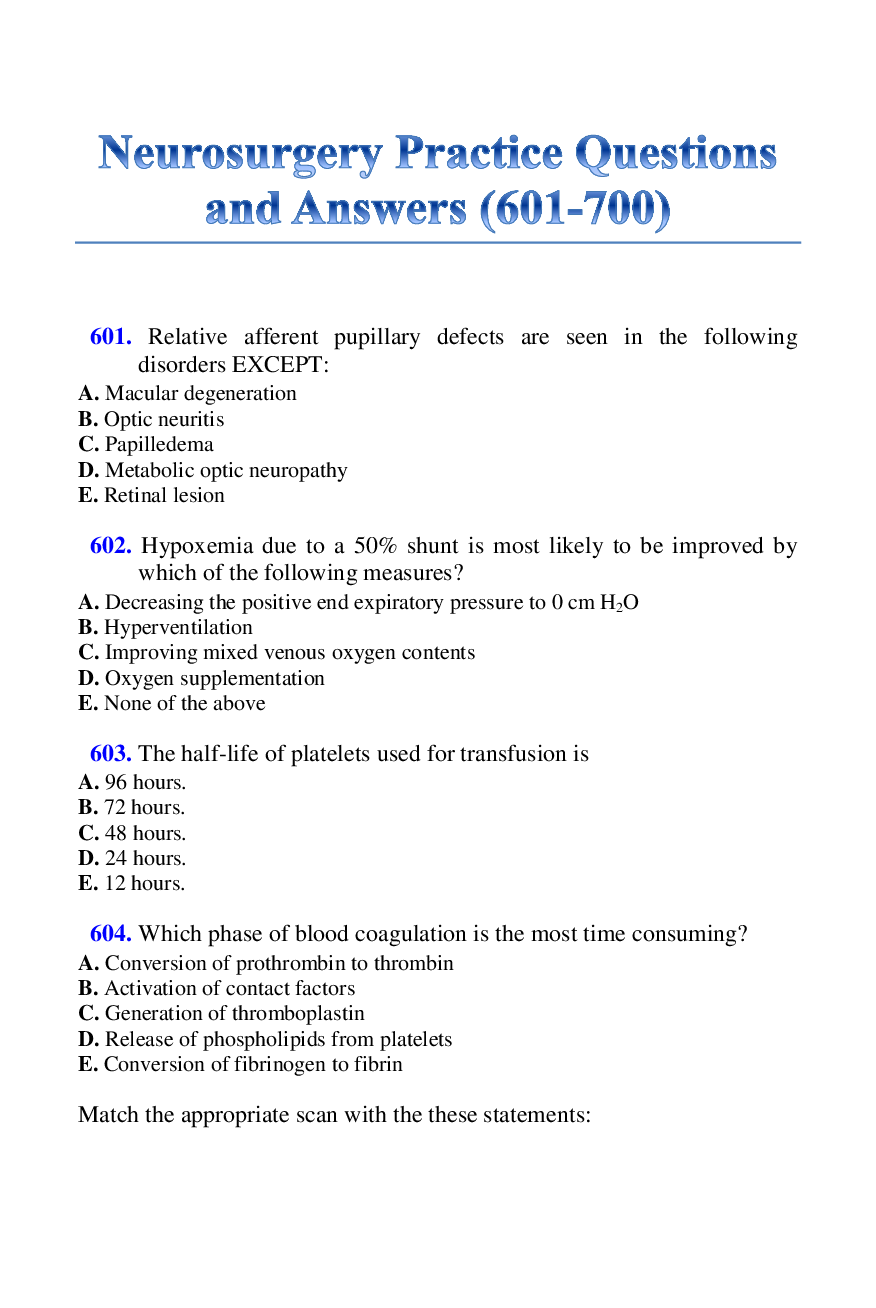*NURSING > QUESTIONS & ANSWERS > NPTE MODALITIES PRACTICE QUESTIONS and answers, Questions Bank Rated A+ (All)
NPTE MODALITIES PRACTICE QUESTIONS and answers, Questions Bank Rated A+
Document Content and Description Below
NPTE MODALITIES PRACTICE QUESTIONS and answers, Questions Bank Rated A+ Which situation would warrant the coolest water temperature? a. pain management b. general exercise c. treatment of... burns d. chronic osteoarthritis - ✔✔Answer: b Rationale: The temperature of water for general exercise should be between 79-92 degrees Fahrenheit. Water temperature would need to be significantly higher for the remaining options: pain management 99-104 degrees Fahrenheit; treatment of burns 96-98 degrees Fahrenheit; chronic osteoarthritis 104-110 degrees Fahrenheit A therapist plans to administer cryotherapy to a patient for a period of seven minutes. What type of cryotherapeutic agent would be most likely based on the planned duration of the treatment? a. cold bath b. ice massage c. cold pack d. vapocoolant spray - ✔✔Answer: b Rationale: Ice massage is typically performed by freezing water in paper cups and applying the ice directly to the treatment area. Since the ice is applied directly, the magnitude of the tissue cooling requires a treatment duration of only five to ten minutes. Ice massage is ideal for small or contoured areas, allows for direct observation of the skin, and is inexpensive to use. What ratio of on:off time is most common when using mechanical compression? a. 1:3 b. 3:1 c. 1:6 d. 6:1 - ✔✔Answer: b Rationale: A 3:1 ratio is generally used for on:off time with inflation between 40 to 100 seconds and deflation between 10 to 35 seconds Which massage technique would not require the use of a lubricant? a. effleurage b. petrissage c. vibration d. friction - ✔✔Answer: d Rationale: Friction is a deep massage technique that penetrates into the depth of a muscle. As a result, a lubricant would make it extremely difficult for the therapist to administer the stroke with the necessary intensity Which of the following would be considered a potential indication for electrotherapy? a. cardiac arrhythmia b. osteomyelitis c. stress incontinence d. seizure disorders - ✔✔Answer: c Rationale: Stress incontinence refers to the unintentional loss of urine and is often prompted by a physical movement or activity such as coughing or sneezing. Pelvic floor muscle weakness is often the cause of this condition. Electrotherapy can be used effectively to increase the strength and coordination of the pelvic floor muscles. Cardiac arrhythmia, osteomyelitis, and seizure disorders are considered contraindications for electrotherapy A therapist uses neuromuscular electrical stimulation with a patient rehabilitating from a knee injury. During the treatment session the therapist adjusts the on:off time ratio to 1:5. Which of the following is consistent with the described ratio? a. 8 seconds on and 40 seconds off b. 10 seconds on and 30 seconds off c. 30 seconds on and 10 seconds off d. 40 seconds on and 8 seconds off - ✔✔Answer: a Rationale: An on:off ratio of 1:5 means that for each second of on time there would be five seconds of off time. Eight seconds of on time and 40 seconds of off time maintains the 1:5 ratio. What electrode configuration includes two electrodes from two different stimulating circuits that are positioned so that the individual currents intersect? a. unipolar b. monopolar c. bipolar d. quadripolar - ✔✔Answer: d Rationale: Quadripolar technique refers to two electrodes from two separate stimulating circuits that are positioned so that the individual currents intersect with each other. This technique is utilized with interferential current. A therapist treats a patient rehabilitating from an ankle sprain using a cold bath. Which value would be most appropriate for the temperature of the cold bath? a. 35 degrees Fahrenheit b. 48 degrees Fahrenheit c. 60 degrees Fahrenheit d. 74 degrees Fahrenheit - ✔✔Answer: c Rationale: A cold bath requires water temperature ranging from 55 to 64 degrees Fahrenheit. Cold baths are commonly used for the immersion of distal extremities. Which term describes the transfer of heat that occurs as a liquid absorbs energy and changes form to a vapor? a. conduction b. convection c. conversion d. evaporation - ✔✔Answer: d Rationale: Evaporation refers to the transfer of heat as a liquid absorbs energy and changes form to a vapor. Vapocoolant sprays are an example of a modality that relies on evaporation for heat transfer. The temperature of the water in a hot pack machine should be: a. 137 degrees Fahrenheit b. 148 degrees Fahrenheit c. 161 degrees Fahrenheit d. 174 degrees Fahrenheit - ✔✔Answer: c Rationale: The water in a hot pack unit should be between 158-167 degrees Fahrenheit A therapist attempts to determine the amount of time necessary to treat an area approximately two times the size of the ultrasound transducer. The most appropriate treatment time is: a. 3 minutes b. 5 minutes c. 7 minutes d. 12 minutes - ✔✔Answer: b Rationale: A therapist can cover an area two to three times the size of the transducer in a five minute period. Five minutes would be a sufficient amount of time given the size of the area in relation to the size of the transducer. Which condition would be considered an indication for cryotherapy? a. chronic pain b. circulatory impairment c. cold urticaria d. ischemic tissue - ✔✔Answer: a Rationale: Chronic pain is an indication for cryotherapy. Other indications include pain control, myofascial pain syndrome, muscle spasm, bursitis, tendonitis, acute or subacute inflammation, and musculoskeletal trauma. Circulatory impairment, cold urticarial, and ischemic tissue are all considered contraindications for cryotherapy. A patient poorly tolerates the sudden increase in force that occurs when transitioning from off time to on time during neuromuscular electrical stimulation. Which action would minimize the impact of this transition? a. decrease the treatment duration b. modify the waveform c. utilize a ramp d. increase the phase duration - ✔✔Answer: c Rationale: Ramp refers to the number of seconds it takes for the amplitude to gradually increase or decrease to the maximum value set by the amplitude control. By adding a ramp the onset of the electrical force will be gradual and, therefore, better tolerated by the patient. Which property of water increases in proportion to the depth of immersion? a. buoyancy b. hydrostatic pressure c. specific gravity d. total drag force - ✔✔Answer: b Rationale: Hydrostatic pressure is the pressure exerted by a fluid at equilibrium due to the force of gravity. Water exerts pressure that is perpendicular to the body and increases in proportion to the depth of immersion. A therapist uses compression to treat a patient with edema. How much inflation pressure is necessary when treating the upper extremities? a. 20 mmHg b. 45 mmHg c. 70 mmHg d. 90 mmHg - ✔✔Answer: b Rationale: Treatment for the upper extremities requires between 30 and 60 mmHg of inflation pressure Which type of hydrotherapy tank would allow the patient to extend their legs, however, would not allow for full body immersion? a. extremity tank b. lowboy tank c. highboy tank d. Hubbard tank - ✔✔Answer: b Rationale: A lowboy tank is used for larger parts of the extremities and permits long sitting with water to the midthoracic level. Approximate dimensions for the lowboy tank are a depth of 18 inches, a length of 52-65 inches, and a width of 24 inches. A therapist elects to use a small set of electrodes when applying electrical stimulation to the anterior forearm of a patient rehabilitating from an upper extremity injury. Which of the following is most accurate when comparing smaller electrodes to larger electrodes? a. Smaller electrodes result in increased current density and increased impedance b. Smaller electrodes result in decreased current density and increased impedance c. Smaller electrodes result in increased current density and decreased impedance d. Smaller electrodes result in decreased current density and decreased impedance - ✔✔Answer: a Rationale: The smaller surface area of small electrodes increases current density and impedance. Current density is a measure of the density of an electrical current. Impedance refers to the property of a substance that provides resistance to the flow of current by offering an alternate current Which ultrasound parameters would produce the lowest total amount of heat delivered to the target area? a. 20% duty cycle at 1.2 W/cm2 b. 50% duty cycle at 1.1 W/cm2 c. 75% duty cycle at 1.3 W/cm2 d. continuous ultrasound at 1.2 W/cm2 - ✔✔Answer: a Rationale: Pulsed ultrasound at a 20% duty cycle produces sound energy only 20% of the time. A 50% duty cycle produces sound energy 50% of the time. Although the intensity is slightly lower at the 50% duty cycle compared to the corresponding intensity for the 20% duty cycle, the relatively small decrease would still generate additional heat due to the significantly increased duty cycle. Which of the following would be considered a contraindication for mechanical lumbar traction? a. muscle spasm b. joint instability c. nerve impingement d. protruding disc - ✔✔Answer: b Rationale: Joint instability is considered a contraindication to mechanical lumbar traction. Muscle spasm, nerve impingement, and protruding disc are indications for traction. What is the most likely treatment objective when administering petrissage? a. loosen adhesions and improve lymphatic return b. enhance circulation and stimulate peripheral nerve endings c. reduce edema and promote relaxation d. diminish trigger points and muscle spasms - ✔✔Answer: a Rationale: Petrissage is a massage technique described as kneading where the muscle is squeezed and rolled under the therapist's hands. The treatment objective of petrissage is to loosen adhesions, improve lymphatic return, and facilitate the removal of metabolic waste from the treatment area. What type of electrical current is used with iontophoresis? a. alternating current b. direct current c. pulsatile current d. interferential current - ✔✔Answer: b Rationale: Direct current refers to a continuous unidirectional flow of charged particles. Direct current is used for iontophoresis and for stimulating contraction of denervated muscle. A therapist applies a hot pack to the lower back of a patient positioned in prone. How long after administering the hot pack should the therapist examine the patient's skin? a. 1 minute b. 5 minute c. 10 minutes d. 20 minutes - ✔✔Answer: b Rationale: A therapist should check a patient's skin for redness or signs of a burn shortly after applying the hot pack. Five minutes would be an ideal time to check the patient's skin since there would be ample time for thermal effects; however, there would be insufficient time for a serious reaction given the number of towel layers required. What is the maximum depth of tissue heating when using ultrasound with a frequency of 1 MHz? a. one centimeter b. two centimeters c. five centimeters d. ten centimeters - ✔✔Answer: c Rationale: Ultrasound with a frequency of 1 MHz can be used to heat tissues up to five centimeters deep, while ultrasound with a frequency of 3 MHz is used to heat tissue one to two centimeters deep. A therapist positions a patient in supine prior to initiating mechanical cervical traction. How much neck flexion should be present? a. 5-10 degrees b. 10-15 degrees c. 25-35 degrees d. 45-55 degrees - ✔✔Answer: c Rationale: When administering mechanical traction to the cervical spine with the patient in a supine position, the neck should be flexed 25-35 degrees. Traction to the cervical spine can also occur with the patient in a sitting position. What parameter is primarily responsible for determining the depth of ultrasound? a. intensity b. duty cycle c. frequency d. effective radiating area - ✔✔Answer: c Rationale: The selected frequency of ultrasound determines the depth of penetration. Frequency is most often 1 MHz or 3 MHz. Increasing the frequency of ultrasound causes a decrease in the depth of penetration and decreasing the frequency causes an increase in the depth of penetration. What form of heat transfer is used by hot packs? a. conduction b. convection c. conversion d. evaporation - ✔✔Answer: a Rationale: Hot packs transfer heat through conduction. This type of heat transfer occurs as a result of direct contact between two materials at different temperatures. How much force should be used initially when performing mechanical traction to the cervical spine? a. 5 pounds b. 10 pounds c. 25 pounds d. 50 pounds - ✔✔Answer: b Rationale: A force between 10 and 15 pounds is often used to initiate mechanical cervical traction. Seven percent of the patient's body weight may be necessary for separation of the vertebrae. A therapist uses iontophoresis to treat a patient with a fungal infection. Which substance would be the most beneficial to utilize? a. copper sulfate b. calcium chloride c. lidocaine d. zinc oxide - ✔✔Answer: a Rationale: Copper sulfate can be used with iontophoresis to treat fungal infections. The medication has a positive polarity. Which therapeutic modality transfers heat through convection? a. hot pack b. whirlpool c. paraffin d. ice massage - ✔✔Answer: b Rationale: Whirlpool transfers heat to the body through convection. Convection refers to the gain or loss of heat as a result of air or water moving in a constant motion across the body. Which of the following would not be considered a nonthermal effect of ultrasound? a. increased soft tissue repair b. increased macrophage responsiveness c. increased extensibility of collagen structures d. increased cell membrane permeability - ✔✔Answer: c Rationale: Increased extensibility of collagen structures would be considered a thermal effect of ultrasound. The increase in tissue temperature generated by ultrasound is necessary to increase the extensibility of collagen structures. An increase in tissue temperature does not occur with nonthermal effects. Which of the following substances administered with iontophoresis can be used to treat myositis ossificans? a. acetic acid b. dexamethasone c. magnesium sulfate d. zinc oxide - ✔✔Answer: a Rationale: Myositis ossificans is a condition that causes abnormal bone formation within deep muscle tissue. Several studies suggest that acetic acid can be useful to treat patients with myositis ossificans. Which massage technique utilizes small circular motions over a trigger point or muscle spasm? a. effleurage b. friction c. petrissage d. tapotement - ✔✔Answer: b Rationale: Friction is a deep massage technique that utilizes small circular motions over a trigger point or muscle spasm. Friction requires penetration into the depth of a muscle. Which of the following is an indication for hydrotherapy? a. impaired circulation b. desensitization of a residual limb c. incontinence d. diminished sensation - ✔✔Answer: b Rationale: Desensitization of a residual limb can occur using a contrast bath. Impaired circulation, incontinence, and diminished sensation are considered contraindications to hydrotherapy. What massage technique uses rapid, alternating movements such as tapping and cupping? a. effleurage b. tapotement c. petrissage d. friction - ✔✔Answer: b Rationale: Tapotement is a massage technique that provides stimulation though rapid, alternating movements such as tapping, hacking, cupping, and slapping. The primary purpose of tapotement is to enhance circulation and stimulate peripheral nerve endings. What percentage of body weight is necessary for mechanical separation of the lumbar spine when using spinal traction? a. 10 percent b. 25 percent c. 40 percent d. 50 percent - ✔✔Answer: d Rationale: A force of 25-50 pounds is recommended when initiating mechanical lumbar traction, however, 50 percent of body weight is necessary for actual separation of the vertebrae. Which type of electrical current is characterized as twin-peak, monophasic pulsed current? a. direct current b. alternating current c. interferential current d. high-voltage pulsed current - ✔✔Answer: d Rationale: High-voltage pulsed current is a twin-peak monophasic pulsed current. High-voltage pulsed current is commonly used in wound healing and pain management. How many towel layers are generally recommended when using a hot pack? a. 2-4 b. 4-6 c. 6-8 d. 8-10 - ✔✔Answer: c Rationale: A therapist should use 6-8 towel layers around a hot pack before applying a hot pack to a patient. If a therapist uses hot pack covers, each cover counts as two towel layers. A therapist uses iontophoresis to treat a patient diagnosed with lateral epicondylitis. Which of the following would be the most necessary to monitor during the session? a. blood pressure b. respiration rate c. heart rate d. skin - ✔✔Answer: d Rationale: The therapist must monitor the patient during treatment to ensure that the skin is not burned under the electrode. The skin should be thoroughly clean before and after treatment to minimize irritation. Vital signs are not typically affected by iontophoresis. Which ultrasound parameters are most likely to produce purely nonthermal effects? a. low intensity, low duty cycle b. low intensity, high duty cycle c. high intensity, low duty cycle d. high intensity, high duty cycle - ✔✔Answer: a Rationale: Ultrasound using nonthermal effects is characterized by no measurable net increase in temperature. This occurs by using a relatively low intensity and low duty cycle. In this manner the heat generated during the on time of the cycle is dispersed during the off time. Which unit is considered a measure of frequency when using electrical stimulation? a. microseconds b. Hertz c. amperes d. volts - ✔✔Answer: b Rationale: Frequency describes the number of cycles (Hertz) or pulses per second (pps) for pulsatile current. Which term is responsible for the upward force on the body when immersed in water? a. buoyancy b. hydrostatic pressure c. specific gravity d. total drag force - ✔✔Answer: a Rationale: Buoyancy is the upward force caused by fluid pressure that keeps objects afloat. According to Archimedes' principle of buoyancy there is an upward force on the body when immersed in water equal to the amount of water that has been displaced by the body. Which type of hydrotherapy tank would hold the largest volume of water? a. extremity tank b. lowboy tank c. highboy tank d. Hubbard tank - ✔✔Answer: d Rationale: A Hubbard tank is used for full body immersion and can hold up to 425 gallons. Approximate dimensions for the Hubbard tank are a depth of four feet, a length of eight feet, and a width of six feet. A therapist treats a patient with the objective of muscle relaxation using biofeedback. Assuming the patient makes progress during several sessions, the therapist should: a. move the electrodes further apart and increase the sensitivity setting b. move the electrodes further apart and decrease the sensitivity setting c. move the electrodes closer together and increase the sensitivity setting d. move the electrodes closer together and decrease the sensitivity setting - ✔✔Answer: a Rationale: Moving the electrodes further apart and increasing the sensitivity setting will make the activity more challenging for the patient. A higher sensitivity level will require the muscles to be in a more relaxed state. How much inflation pressure is necessary when treating the lower extremities with compression? a. 20 mmHg b. 35 mmHg c. 60 mmHg d. 85 mmHg - ✔✔Answer: c Rationale: Treatment for the lower extremities requires between 40 and 80 mmHg of inflation pressure. The inflation pressure should not exceed the patient's diastolic blood pressure. A therapist would like to increase the lower extremity resistance a patient experiences while exercising in a therapeutic pool. The most appropriate therapist action is: a. increase the depth of water b. decrease the level of body immersion c. increase the speed of movement d. decrease the duration of the exercise - ✔✔Answer: c Rationale: Resistance in water increases in proportion to the speed of the motion. The amount of resistance is also influenced by the shape and size of the object (i.e., lower extremity). Which formula is the most appropriate for determining duty cycle when using electrical stimulation? a. on time divided by off time b. on time divided by total time (on time plus off time) c. off time divided by on time d. off time divided by total time (on time plus off time) - ✔✔Answer: b Rationale: Duty cycle refers to the percentage of time that electrical current is on in relation to the entire treatment time. Duty cycle equals on time divided by total time (on time and off time). A therapist treats a patient with a cold pack for 30 minutes. Which condition would most warrant the stated treatment period? a. acute pain b. spasticity c. bursitis d. subacute inflammation - ✔✔Answer: b Rationale: Cryotherapy used to reduce spasticity may extend to period of 30 minutes. Use of a cold pack for traditional therapeutic benefits (e.g., decrease inflammation, promote analgesia, decrease metabolism) typically requires a duration of 15 minutes. Which substance used with iontophoresis has a positive polarity? a. lidocaine b. salicylates c. dexamethasone d. calcium chloride - ✔✔Answer: a Rationale: Lidocaine has a positive polarity and is used with iontophoresis to provide analgesia and treat inflammation. Salicylates, dexamethasone, and calcium chloride have a negative polarity. Which massage technique is performed at the beginning and end of a massage to allow the patient to relax? a. vibration b. petrissage c. effleurage d. tapotement - ✔✔Answer: c Rationale: Effleurage is a massage technique performed at the beginning and end of a massage to help the patient to relax. The technique uses a light stroke and produces a reflexive response. A patient becomes extremely fatigued during a treatment session that includes neuromuscular electrical stimulation to improve muscle strength. Which action would be the most desirable to limit fatigue? a. decrease the phase duration b. increase the off time c. increase the frequency d. decrease the amplitude - ✔✔Answer: b Rationale: Increasing the off time provides the patient with more rest between contractions and therefore serves to limit fatigue during neuromuscular electrical stimulation. A physical therapist reviews the parameters of several pain modulation theories using transcutaneous electrical nerve stimulation (TENS). When comparing sensory stimulation to motor stimulation, sensory stimulation requires: a. greater phase duration b. greater frequency c. stronger amplitude d. shorter treatment time - ✔✔Answer: b Rationale: Frequency is significantly greater with sensory level stimulation compared to motor level stimulation. Motor stimulation requires sufficient phase charge to elicit a muscle contraction. This is accomplished by using a low frequency and long phase duration. Sensory stimulation, also called conventional TENS, requires a sufficient phase charge to achieve a sensory response, but is below the motor threshold. This is accomplished by using a high frequency and short phase duration. A physical therapist administers iontophoresis to a patient with a lower extremity ulceration in an attempt to promote tissue healing. Which ion would BEST meet the stated objective? a. acetate b. magnesium c. lidocaine d. zinc - ✔✔Answer: d Rationale: Zinc, from zinc oxide, is a positively charged ion used to promote healing, most often with open lesions and ulcerations. Iontophoresis refers to the transcutaneous delivery of ions into the body for therapeutic purposes using an electrical current. Physical therapists must possess an in-depth awareness of the most appropriate ions to treat specific conditions. A physical therapist incorporates electrical stimulation as part of the plan of care for a patient rehabilitating from a lower extremity injury. Which of the following recommendations would be LEAST effective to minimize electrode resistance? a. keep the sponge interface well moistened b. use small electrodes c. maintain even, firm contact with the skin d. remove hair from the skin - ✔✔Answer: b Rationale: Small electrodes increase electrode resistance, while large electrodes decrease electrode resistance. Resistance refers to the opposition to electron flow in a conducting material A physical therapist would like to minimize the likelihood of a burn when using iontophoresis. Which action would be the MOST consistent with the therapist's objective? a. increase the size of the cathode relative to the anode b. decrease the space between the electrodes c. increase the current intensity d. decrease the moisture of the electrodes - ✔✔Answer: a Rationale: Current density (mA/cm2) is calculated by taking the current amplitude (mA) and dividing by the surface area (cm2). Greater current density will result in an increased risk of an electrochemical burn. Increasing the size of the cathode relative to the anode serves to decrease current density and therefore reduces the probability of a burn when using iontophoresis. The cathode refers to the negatively charged electrode in a direct current system and the anode refers to the positively charged electrode. The accumulation of positively charged ions in a small area creates an alkaline reaction that is more likely to create tissue damage. As a result, it is desirable to increase the size of the cathode. A physical therapist prepares to administer iontophoresis over the anterior surface of a patient's knee. The therapist would like to keep the current density low in order to avoid skin irritation. Which of the listed parameters would BEST accomplish the therapist's objective? a. current amplitude of 4 mA; electrode with an area of 12 cm2 b. current amplitude of 4 mA; electrode with an area of 4 cm2 c. current amplitude of 3 mA; electrode with an area of 6 cm2 d. current amplitude of 3 mA; electrode with an area of 4 cm2 - ✔✔Answer: a Rationale: The current density may be altered either by increasing or decreasing current intensity or by changing the size of the electrode. Current density with iontophoresis equals current amplitude (mA) divided by electrode size (cm2). Failure to select appropriate treatment or failure to monitor the patient's response to treatment creates and unnecessary safety risk. Current density= 4mA/12cm2= .33mA/cm2 A physical therapist adjusts the on:off time on an electrical stimulation unit prior to beginning treatment. When using the unit for muscle re-education the MOST appropriate on:off ratio is: a. 5:1 b. 15:1 c. 1:5 [Show More]
Last updated: 1 year ago
Preview 1 out of 58 pages

Buy this document to get the full access instantly
Instant Download Access after purchase
Add to cartInstant download
We Accept:

Also available in bundle (1)

The NPTE EXAM BUNDLE
Compries of all Exam Documents with answers, Graded A+
By bundleHub Solution guider 1 year ago
$29
6
Reviews( 0 )
$12.00
Document information
Connected school, study & course
About the document
Uploaded On
Aug 23, 2022
Number of pages
58
Written in
Additional information
This document has been written for:
Uploaded
Aug 23, 2022
Downloads
0
Views
120

























